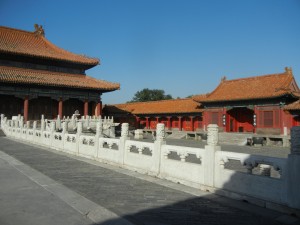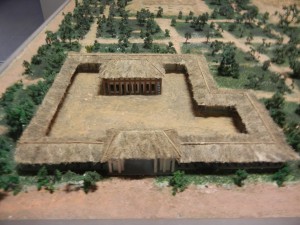In the early fifteenth century, some of the greatest hallmarks of the Italian Renaissance were created in Florence. They include Alberti’s mathematical theory of 3 dimensional perspective, and paintings by Masaccio and Masolino that show the body in its muscular glory. At the same time, China’s Ming Dynasty emperor Yongle was constructing the Forbidden City. This has been China’s most important building ever since.
Here are some of the Forbidden City’s salient characteristics.
1. Its forms are well balanced. As the above picture shows, buildings and open spaces blend well. It’s symmetrical, but the buildings differ enough from each other to allow variety. While Europe was focusing more on linear relationships between distinct entities, the Chinese emphasized harmony within the whole.
The Forbidden city expresses a lot of other ancient ideas. Yongle referred back to China’s cultural legacy to order the new capital he was building.
2. The basic form of the Forbidden city goes back at least to the early Shang dynasty. The site of Erlitou has a palace with a pavilion in the center of a large open courtyard, surrounded by a wall. The emperor in the center, surrounded by his lords, ministers and the people, and all within an enclosure–this has been a model of harmony that has been central in Confucianism. This form was at least 3,000 years old when the Forbidden City was built.
The Qin and Han dynasties expanded the combination of pavilion, courtyard and walled enclosure into palaces the size of cities. The Greeks built colonnaded temples as models of order. They’re perfect distinct entities. The Chinese strengthened their ideas of the royal court’s harmony and its resonance with cosmic order.
3. The Forbidden City is laid out according to the cardinal directions, with the main entrance in the south, and the royal residence in the north. Buildings face south to benefit from yang energies, including the warm sun.
Almost 200,000 workers toiled to build the Forbidden City between 1407 and 1420. Yongle put a wealth of ancient ideas into his palace to ensure harmony throughout the land. But these ideas and the real world would be in a dynamic tension for the next 500 years.



Comments on this entry are closed.